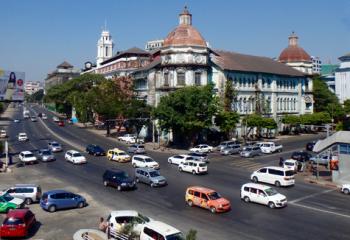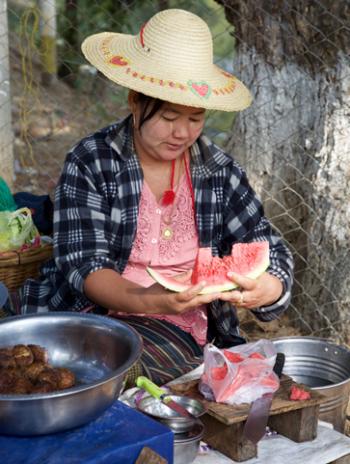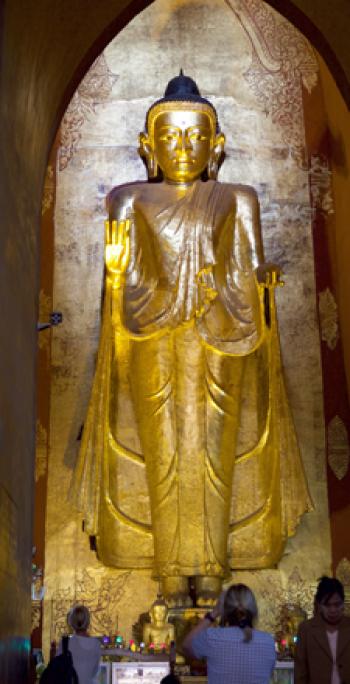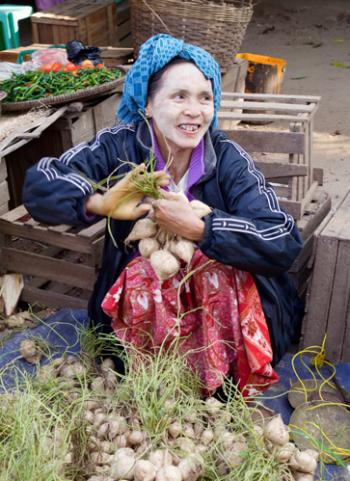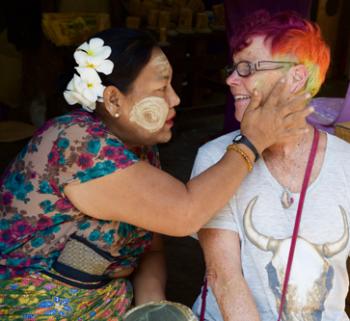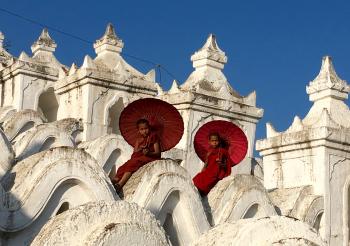Lessons from a medical emergency on a Myanmar cruise
This item appears on page 28 of the June 2017 issue.
My wife, Betty, and I took an enjoyable cruise from Yangon to Mandalay, Myanmar, in January 2016. We sailed aboard the 56-passenger riverboat AmaPura on a 14-day, 14-night itinerary with Ama Waterways (Calabasas, CA; 800/626-0126, www.amawaterways.com).
The two of us paid $17,000, which included travel insurance, a Mandalay-Yangon flight and a night’s lodging in Yangon. (We would fly from Mandalay to Yangon after the cruise, continuing to Vietnam for a private tour.)
We arrived three days before the cruise start date and enjoyed two days of touring in Yangon arranged separately through Tour Mandalay (Bahan Township, Yangon, Myanmar; phone +95 1 540475, www.tourmandalay.travel). The price of $160 per person excluded meals but covered all site entry fees. The private guide and driver services were excellent.
This pre-cruise tour was well worth the effort of arranging, as we spent much more time visiting the sites AmaWaterways includes on their own half-day tour of Yangon plus other sites of interest. Consequently, during the ship’s Yangon excursion, we opted to remain on board and relax.
(AmaWaterways’ northbound itinerary starts with one shorter excursion per day and shifts to two excursions per day or all-day excursions as the boat moves toward Mandalay. Some guests indicated the schedule was too slow at the beginning. Cruising from Mandalay to Yangon would result in having the less-active days at the end of the trip. An alternative is selecting the 10-day itinerary, but that requires a 6-hour bus trip between Yangon and Pyay. We were fine with the 14-day program.)
Before and during each shore excursion, cruise managers provided information about the area.
Because river touring has only recently opened up in Myanmar, some of the excursions between Yangon and Bagan focused more on local life than on spectacular cultural or historical sites.
There were no groups for “more active” or “slower” walkers, and the walking pace of all of the shore excursions was generally slow. There was little accessibility accommodation in Myanmar for those with walking limitations. Often, there were no stair handrails at excursion stops.
On temple and pagoda visits, shoes had to be removed. In many cases, visitors also had to remove their socks. Generally, the temple and pagoda tiles and floors were very dusty, so we found it better to simply avoid wearing socks. Wipes for our feet were provided by the ship’s staff after each stop where shoes had to be removed.
The AmaPura staff all were very friendly and extremely service-oriented. It was nice to be welcomed back by the captain and crew members after each excursion.
The food on board included regional Asian dishes and Western selections along with tasty local fruits and vegetables. Breakfasts and lunches were buffet-style, with some personalized dishes. Complimentary wine and beer were provided at lunch and dinner.
Our third-level cabin was nicely furnished. The balcony was convenient, but we rarely used it.
Onboard laundry service was available, but our travel clothes wash and dry easily and we tended to do more hand-wash, stringing our portable clothesline with suction cups in our bathroom.
I’m a light sleeper and an early riser most days, and I found it difficult to sleep past 6 a.m. due to the loud engines of small boats traveling on the river plus the early-morning music played by temples on the riverbank. Noise-canceling insert earphones were helpful, but I usually just got up, grabbed a cup of coffee from the lounge and chatted with other early-risers.
The weather was often very cool in the early mornings and moderately warm during the day. We didn’t experience high humidity or any rain during the day.
In regard to January insect life, we did experience a few mosquitoes in Yangon. We took antimalarial pills.
The air along the Ayeyarwady was generally smoke- and dust-laden, so including eyedrops and cough drops on a packing list is recommended, along with antihistamine drops for itchy eyes. A dust mask may be helpful too. Some guests developed respiratory issues.
•
A friend traveling with my wife and me developed pneumonia about halfway through the cruise and was transferred by ambulance to a hospital in Mandalay. As I understood, this was the first medical evacuation the AmaPura had had in two years. The ship’s staff were extremely attentive and supportive during the incident.
As my wife and I worked on visiting the hospital and preparing medical-evacuation insurance documentation for our friend, AmaPura staff arranged for a bilingual driver to take us from the ship to the hospital (understandably, at our expense). Also, we rescheduled our travel from Mandalay so that we had more time to be sure our friend would be evacuated back to the US.
We found hospital conditions in Myanmar very different from those in the US. Once our friend was admitted to a private room, we were informed that we needed to pay in advance (in kyat, the local currency), supply our own food and water for her and, for more attentive care, hire a private nurse assistant. The bathing equipment was essentially a plastic tub with a ladle. AmaWaterways kindly shared ship supplies such as water bottles, toilet paper and tissues.
We requested the physicians to complete the insurance paperwork and were asked to email our forms to a hospital physician and return at 4 p.m. to pick up the updated forms. I sent the email at 9 a.m. When we returned to the hospital at 4, we were told the forms had not been received by the physician, as the hospital did not have Internet access. The request for me to email the forms to the physician seemed curious, at best.
Our bilingual driver took me to a Mandalay copy shop, where I printed the forms. Once they were filled out at the hospital, AmaPura staff scanned the forms into a PDF in the ship’s office, then assisted me in emailing the documents via personal cell phone to the insurance contact in the US.
This fiasco with filling out insurance forms set us back a day.
•
Having learned a number of lessons from our experience, we offer the following suggestions.
• When purchasing trip insurance, confirm that you’re covered for medical evacuation to a hospital or facility located near your home and not just to a local hospital.
• Take a printed copy of ALL insurance forms and instructions with you on your cruise.
• Start contacting your travel insurance company as soon as emergency medical assistance is requested. (We waited until the following day, and, in the best case, this would have placed us several hours behind on submitting paperwork.)
• Read carefully the instructions for submitting insurance paperwork. The form may ask for an incident description, certain codes and physician-treatment notes. Note the section on “assignment of benefits,” which is the mechanism through which the insured person authorizes the insurer to reimburse the local service provider for covered services.
Simply forwarding the “assignment of benefits” section to the insurer may permit the insurer to open a formal incident report and assign a case manager. If you wait until the physician-treatment notes are available and all the forms are completed before doing this, you may delay your insurance assistance and/or evacuation.
• Take an unlocked cell phone with you and purchase a local SIM card for its use. In Myanmar, a SIM is very inexpensive — MMK1,500 (near $1.10) — and, given the ship’s poor Internet connectivity, a phone may be critical for arranging emergency-medical-evacuation assistance. (Possession of even a network-locked GSM cellular phone in Myanmar may be useful, though possibly costly, in an emergency medical situation.)
Purchase additional SIM top-up cards (MMK10,000, perhaps) to ensure that enough cellular phone, messaging and Internet time is available.
• Despite statements in the marketing material distributed by the emergency-medical-evacuation insurer, there may NOT be any local/regional emergency personnel to accompany a solo traveler back to the US.
In this instance, it took several days for the insurer to arrange for a nurse to travel from Bangkok, Thailand, to Mandalay to accompany our friend back to the US. Be prepared to deal with this type of delay.
• A local physician may be unwilling to discharge a patient to fly home. This doesn’t necessarily rule out discharging the patient to a local hotel catering to Westerners while an antibiotic regimen is completed and/or evacuation assistance arrives.
• When contacting the medical-evacuation call center emergency number, it may be beneficial to request a case manager. This will help you avoid having to repeat details to each representative you reach when calling the center.
• To pay the hospital, take two different ATM cards for withdrawing local currency or travel with a companion who also has an ATM card. (Our friend’s ATM card wasn’t accepted by multiple machines, but we were able to use our card to withdraw kyat.)
A short Myanmar hospital stay could easily run MMK500,000 to MMK1,000,000 (near $366-$732).
Overall, we enjoyed our AmaWaterways cruise and would recommend it to others. It reminded us, though, that a little advance planning for emergency situations can go a long way.
ROBERT ONO
Davis, CA

